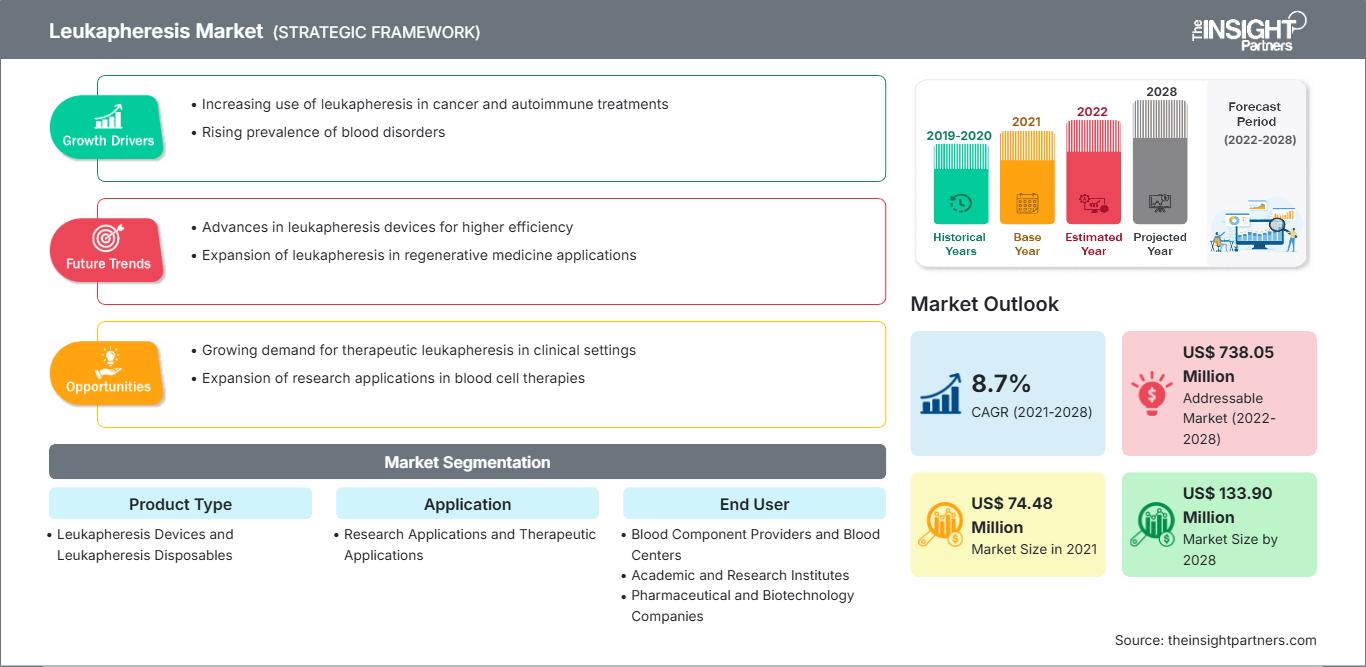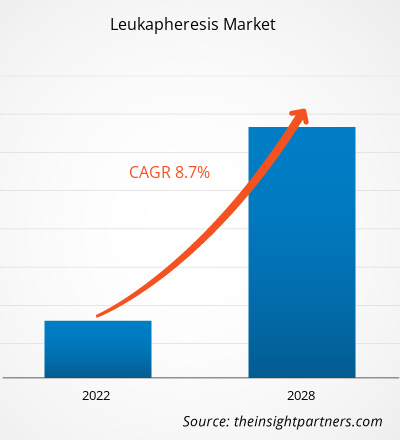[연구 보고서] 백혈구채집술 시장은 2021년 7,448만 달러에서 2028년 1억 3,390만 달러로 성장할 것으로 예상되며, 2021년부터 2028년까지 연평균 8.7% 성장할 것으로 예상됩니다.
백혈구채집술은 신체의 면역 반응에 관여하는 백혈구를 혈액 샘플에서 분리하는 시술입니다. 적혈구나 혈소판과 같은 혈액 성분을 채취한 후 남은 혈액을 순환계에 다시 공급하는 특수한 형태의 혈액채집술입니다. 백혈구채집술은 만성 림프구성 백혈병(CLL)과 같은 만성 혈액암과 같이 매우 높은 백혈구(WBC) 수치를 낮추는 데 자주 사용됩니다. 또한 항암 화학요법 중 백혈구 수치가 급격히 감소하는 경우와 같이 추후 이식을 위해 백혈구를 채취하기 위해 시행될 수도 있습니다. 또 다른 용도는 백혈병, 전립선암 및 기타 암 치료에 사용되는 키메라 항원 수용체(CAR) T 세포 요법이라는 새로운 면역 요법의 한 부분으로 활용되는 것입니다. 백혈구 성분채집술은 치료를 받는 사람(자가 성분채집술) 또는 추후 이식을 위한 기증자(동종이식 성분채집술)에게 시행될 수 있습니다. 현재 백혈구 성분채집술은 다양한 질병 치료에 널리 사용되고 있으며, 순환 종양 세포 수율을 높일 수 있어 진단 목적으로도 사용됩니다. 자발적 헌혈자 수 증가, 혈액 질환 발병률 증가, 고령 인구 급증 등의 요인이 백혈구 성분채집술 시장 성장을 촉진하고 있습니다. 그러나 백혈구 성분채집술의 높은 비용은 시장 성장을 어느 정도 저해하고 있습니다.
이 보고서의 일부, 국가 수준 분석, Excel 데이터 팩을 포함하여 모든 보고서에 대한 사용자 정의를 무료로 받을 수 있을 뿐만 아니라 스타트업 및 대학을 위한 훌륭한 제안 및 할인을 이용할 수 있습니다
백혈구채집술 시장: 전략적 통찰력

-
이 보고서의 주요 주요 시장 동향을 확인하세요.이 무료 샘플에는 시장 동향부터 추정 및 예측에 이르기까지 데이터 분석이 포함됩니다.
수혈은 여러 국가의 국가 보건 인프라와 정책에서 필수적인 부분입니다. 의료 산업의 발전은 심각한 질병과 부상에 대한 치료 절차를 개선했고, 궁극적으로 환자의 생존을 위한 수혈의 필요성을 증대시켰습니다. 의료 서비스에서 수혈과 혈액 가용성의 중요성에 대한 인식이 높아짐에 따라 의학적 목적으로 헌혈하려는 사람들의 수가 증가했습니다. 세계보건기구(WHO) 자료에 따르면 2018년 전 세계적으로 약 1억 1,740만 건의 헌혈이 보고되었습니다. 헌혈자는 일반적으로 자발적 무급 헌혈, 유급 헌혈, 가족/대체 헌혈로 분류되며, WHO의 주장에 따르면 자발적/무급 헌혈자는 안정적이고 충분한 혈액 공급의 주요 공급원입니다. 2019년 WHO 데이터에 따르면, 자발적 무상 헌혈자의 헌혈은 2008년부터 2015년까지 전 세계 139개국에서 1,160만 건 증가했습니다. 헌혈 추세는 저소득 및 중소득 국가에서도 상당한 주목을 받고 있습니다. 2017년 CAG 연례 회의에서 발표된 데이터에 따르면, 2016년에 1,087명의 환자에게 약 13,000건의 시술이 수행되었습니다. 자발적 헌혈자 수의 가장 큰 급증은 동남아시아 국가(83%)와 아메리카(70%)에서 나타났습니다.
많은 국가에서 개발 및 시행된 국가 프로그램은 많은 혈소판 및 혈액 헌혈자를 더욱 유치하고 있습니다. 예를 들어, 인도에서는 국가 에이즈 통제 기구(NACO) 내에 구성된 국가 혈액 수혈 위원회(NBTC)가 국가 에이즈 통제 협회(SACS) 내에 설립된 국가 혈액 수혈 위원회(SBTC)와 조정하는 중앙 기관입니다. NBTC는 수혈 서비스(BTS)와 관련된 다양한 활동을 위한 보건 프로그램을 지원합니다. 따라서 전 세계 여러 국가에서 적격 헌혈자 수가 증가함에 따라 필요한 혈액 성분을 분리하는 데 사용되는 백혈구채집술 장비에 대한 수요가 증가하고 있습니다.
제품 유형 기반 인사이트
제품 유형에 따라 백혈구채집술 시장은 백혈구채집술 장치와 백혈구채집술 일회용품으로 구분됩니다. 2021년에는 백혈구채집술 일회용품 부문이 더 큰 시장 점유율을 기록했습니다. 그러나 백혈구채집술 장치 부문은 2021년부터 2028년까지 더 높은 연평균 성장률을 기록할 것으로 예상됩니다.
응용 분야 기반 인사이트
백혈구채집술 시장은 응용 분야별로 연구 분야와 치료 분야로 구분됩니다. 2021년에는 연구 응용 분야가 시장 점유율이 더 높았으며, 향후 몇 년 동안 동일한 분야가 더 높은 CAGR을 기록할 것으로 예상됩니다.
최종 사용자 기반 인사이트
백혈구채집술 시장은 최종 사용자 기준으로 제약 및 생명공학 기업, 학술 및 연구 기관, 혈액 성분 공급업체 및 혈액 센터, 병원 및 수혈 센터로 구분됩니다. 2021년에는 혈액 성분 공급업체 및 혈액 센터 부문이 시장 점유율이 가장 높았습니다. 반면, 병원 및 수혈 센터 부문은 향후 몇 년 동안 가장 높은 CAGR을 기록할 것으로 예상됩니다.
백혈구채집술 시장에서 활동하는 기업들은 제품 출시, 인수합병, 협업, 제품 혁신, 제품 포트폴리오 확장 등의 전략을 채택하여 전 세계로 사업을 확장하고, 브랜드 인지도를 유지하며, 최종 사용자의 증가하는 수요를 충족하고 있습니다.
백혈구채집술 시장 지역별 통찰력
The Insight Partners의 분석가들은 예측 기간 동안 백혈구채집술 시장에 영향을 미치는 지역별 동향과 요인들을 면밀히 분석했습니다. 이 섹션에서는 북미, 유럽, 아시아 태평양, 중동 및 아프리카, 그리고 중남미 지역의 백혈구채집술 시장 세분화 및 지역별 분포도 살펴봅니다.
백혈구채집술 시장 보고서 범위
| 보고서 속성 | 세부 |
|---|---|
| 시장 규모 2021 | US$ 74.48 Million |
| 시장규모별 2028 | US$ 133.90 Million |
| 글로벌 CAGR (2021 - 2028) | 8.7% |
| 이전 데이터 | 2019-2020 |
| 예측 기간 | 2022-2028 |
| 다루는 세그먼트 |
By 제품 유형
|
| 포함된 지역 및 국가 |
북미
|
| 시장 선도 기업 및 주요 회사 프로필 |
|
백혈구채취 시장 참여자 밀도: 비즈니스 역학에 미치는 영향 이해
백혈구 성분채집술 시장은 소비자 선호도 변화, 기술 발전, 그리고 제품 효능에 대한 인식 제고 등의 요인으로 인한 최종 사용자 수요 증가에 힘입어 빠르게 성장하고 있습니다. 수요가 증가함에 따라 기업들은 제품 및 서비스 확장, 소비자 니즈 충족을 위한 혁신, 그리고 새로운 트렌드를 적극 활용하며 시장 성장을 더욱 가속화하고 있습니다.

- 을 얻으세요 백혈구채집술 시장 주요 주요 플레이어 개요
- 백혈구채취 장치
- 채혈 장치
- 백혈구채취 컬럼 및 세포 분리기
- 백혈구 감소 필터
- 백혈구채취 일회용품
백혈구채취 시장 - 응용 분야별
- 연구 응용 분야
- 치료 응용 분야
백혈구채취 시장 - 최종 사용자별
- 제약 및 생명공학 회사
- 학계 및 연구 기관
- 혈액 성분 공급업체 및 혈액 센터
- 병원 및 수혈 센터
백혈구채취 시장 - 지역별
-
북미
- 미국
- 캐나다
- 멕시코
-
유럽
- 프랑스
- 독일
- 이탈리아
- 영국
- 스페인
- 나머지 유럽
-
아시아 태평양(APAC)
- 중국
- 인도
- 대한민국
- 일본
- 호주
- 나머지 아시아 태평양
-
중동 및amp; 아프리카(MEA)
- 남아프리카
- 사우디아라비아
- UAE
- 중동 및 기타 지역 및amp; 아프리카
-
남아메리카(SAM)
- 브라질
- 아르헨티나
- 남아메리카 및 중미 지역
회사 프로필
- 아사히 카세이 주식회사
- 프레세니우스 SE & Co. KGaA
- 헤모네틱스 주식회사
- 테루모 주식회사
- 스템셀 테크놀로지스 주식회사
- 헤마케어
- 마코파마
- 올셀스
- 스템익스프레스
- 바이오IVT
- 과거 분석(2년), 기준 연도, CAGR을 포함한 예측(7년)
- PEST 및 SWOT 분석
- 시장 규모 가치/거래량 - 글로벌, 지역, 국가
- 산업 및 경쟁 환경
- Excel 데이터세트
최근 보고서
사용 후기
구매 이유
- 정보에 기반한 의사 결정
- 시장 역학 이해
- 경쟁 분석
- 고객 인사이트
- 시장 예측
- 위험 완화
- 전략 기획
- 투자 타당성 분석
- 신흥 시장 파악
- 마케팅 전략 강화
- 운영 효율성 향상
- 규제 동향에 발맞춰 대응






















 무료 샘플 받기 - 백혈구채집술 시장
무료 샘플 받기 - 백혈구채집술 시장